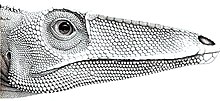Coelophysis rhodesiensis
|
Coelophysis rhodesiensis Temporal range: Early Jurassic, 199–188 Ma |
|
|---|---|
 |
|
| Life restoration | |
| Scientific classification | |
| Kingdom: | Animalia |
| Phylum: | Chordata |
| Class: | Reptilia |
| Clade: | Dinosauria |
| Order: | Saurischia |
| Suborder: | Theropoda |
| Family: | †Coelophysidae |
| Genus: | †Coelophysis |
| Species: | †C. rhodesiensis |
| Binomial name | |
|
Coelophysis rhodesiensis (Raath, 1969) |
|
| Synonyms | |
|
|
Coelophysis rhodesiensis is an extinct species of coelophysid theropod dinosaur that lived approximately 188 million years ago during the early part of the Jurassic Period in what is now Africa. The species was a small to medium-sized, lightly built, ground-dwelling, bipedal carnivore, that could grow up to 3 m (9.8 ft) long. It was formerly called Syntarsus, but that name was already taken by a beetle, and was subsequently given the name Megapnosaurus by Ivie, Ślipiński & Węgrzynowicz, in 2001, though many subsequent studies have classified it in the genus Coelophysis.
Coelophysis rhodesiensis measured up to 3 meters (10 ft) long from nose to tail and weighed about 32 kilograms (70 lb). The bones of 30 C. rhodesiensis individuals were found together in a fossil bed in Zimbabwe, so paleontologists think it may have hunted in packs. The various fossils attributed to this species have been dated over a relatively large time span – the Hettangian, Sinemurian, and Pliensbachian stages of the Early Jurassic – meaning the fossils represent either a highly successful genus or a few closely related animals all currently assigned to Coelophysis.
Specimen UCMP V128659 was discovered in 1982 and referred to Megapnosaurus kayentakatae by Rowe (1989), as a subadult gracile individual and later, Tykoski (2005) agreed. Gay (2010) described the specimen as the new tetanurine taxon Kayentavenator elysiae, but Mortimer (2010) pointed out that there was no published evidence that Kayentavenator is the same taxon as M. kayentakatae.
...
Wikipedia
